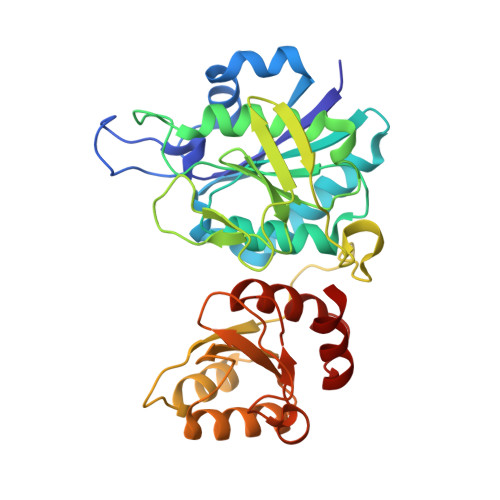The differential ability of asparagine and glutamine in promoting the closed/active enzyme conformation rationalizes the Wolinella succinogenes L-asparaginase substrate specificity.
Nguyen, H.A., Durden, D.L., Lavie, A.(2017) Sci Rep 7: 41643-41643
- PubMed: 28139703
- DOI: https://doi.org/10.1038/srep41643
- Primary Citation of Related Structures:
5K3O, 5K45, 5K4G, 5K4H - PubMed Abstract:
Many side effects of current FDA-approved L-asparaginases have been related to their secondary L-glutaminase activity. The Wolinella succinogenes L-asparaginase (WoA) has been reported to be L-glutaminase free, suggesting it would have fewer side effects. Unexpectedly, the WoA variant with a proline at position 121 (WoA-P 121 ) was found to have L-glutaminase activity in contrast to Uniprot entry P50286 (WoA-S 121 ) that has a serine residue at this position. Towards understanding how this residue impacts the L-glutaminase property, kinetic analysis was coupled with crystal structure determination of these WoA variants. WoA-S 121 was confirmed to have much lower L-glutaminase activity than WoA-P 121 , yet both showed comparable L-asparaginase activity. Structures of the WoA variants in complex with L-aspartic acid versus L-glutamic acid provide insights into their differential substrate selectivity. Structural analysis suggests a mechanism by which residue 121 impacts the conformation of the conserved tyrosine 27, a component of the catalytically-important flexible N-terminal loop. Surprisingly, we could fully model this loop in either its open or closed conformations, revealing the roles of specific residues of an evolutionary conserved motif among this L-asparaginase family. Together, this work showcases critical residues that influence the ability of the flexible N-terminal loop for adopting its active conformation, thereby effecting substrate specificity.
Organizational Affiliation:
The Jesse Brown VA Medical Center, Chicago, Illinois, United States of America.















